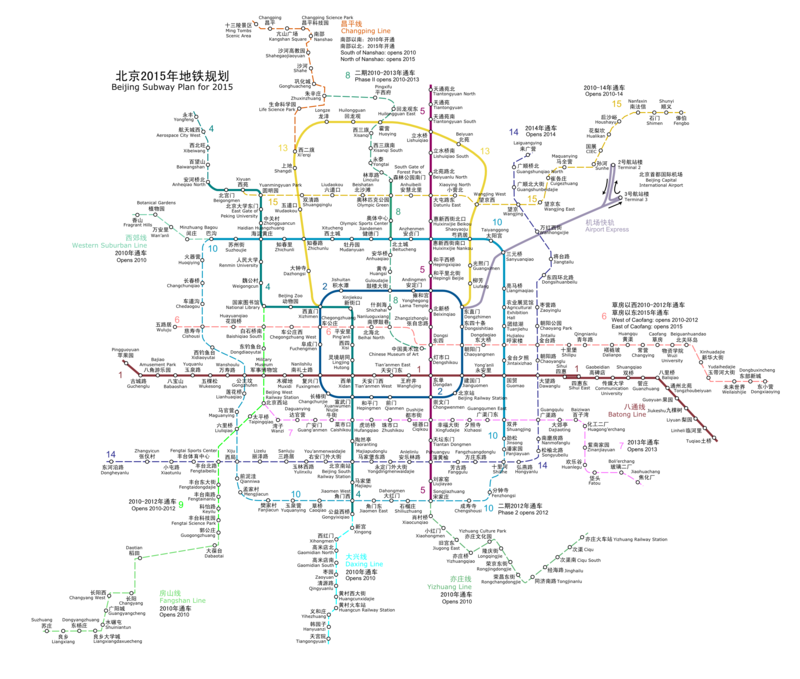The Beijing Metro is an urban and suburban transportation system that provides service to Beijing, the capital of China. This system is one of the busiest in the world, not only due to the large number of people living in China, but also due to how extensive it is. A record 3.78 billion trips were made in 2017.
The Beijing Metro has 370 stations distributed along 608.2 kilometers (378 miles) and 22 lines. This makes it the second largest metro system in the world, surpassed only by the Chinese city of Shanghai.
Founded in 1969, this is the oldest subway in continental China. The system has a complex management system, due to having 5 different operators with various stockholders.
The system schedule varies according to each line but overall runs from about 5:00 a.m. to 12:00 a.m. For distances less than 6 kilometers (3.73 miles). the basic fair is 3 yuan ($US 0.44).
Metros in China: Beijing
The City
Beijing is the capital of the People’s Republic of China, the most populous country in the world and with a 2013 count of 21,150,000 people, Beijing has transformed into one of the most populous cities on the planet.
Beijing is also the current political center of the country’s communist party as well as one of the most famed cities in China’s historic civilization. It is located in northeast China and the second most populous city in China, just behind Shanghai.
Beijing has become the center for tourism for millions of people worldwide, with notable sites like the Forbidden City, the Temple of Heaven, the Summer Palace, and remnants of the original Great Wall of China and the Grand Canal. Each one has been recognized as a UNESCO World Heritage Site.
The Chinese capital is surrounded by mountains and its divisions are likewise maintained by its internal walls. The modern-age has reached Beijing as well, transforming it into a city with significant skyscrapers and economic centers.
The city has developed a major university and technological presence as well, with development hubs like Zhongguancun.
The city’s moderate climate is typical of the northern hemisphere. The temperature is usually between 5 °C (41 °F) and -8 °C (17.6 °F) during cold months and reaches up to 30 °C (86 °F) during the summer, though it can fall below 13 °C (55.4 °F).
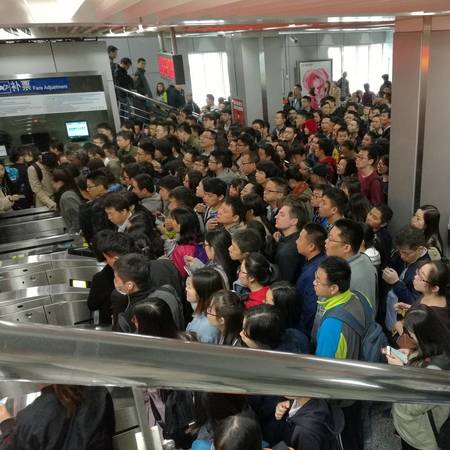 Beijing Metro
Beijing Metro
The Metro
The Beijing Metro is the most important means of transportation in this Chinese capital. It was founded on October 1, 1969, making it the first metro system in the People’s Republic of China.
There were two metro lines until 2002, when a rapid-paced expansion left it with 22 lines and a length of 608.2 kilometers (378 miles). The metro now has 370 stations. The goal is to reach 1000 kilometers (621.4 miles) by 2021.
The Beijing Metro’s rolling stock varies. There have been three generations throughout its history. However, when the massive construction work began in 2002, the system began to exclusively use the rolling stock of Changchun Railway Vehicles Company Ltd, a subsidiary of China CNR Corp.
Recently, the Beijing Metro has begun to incorporate trains manufactured by Qingdao Sifang Locomotive & Rolling Stock Co., Ltd., a subsidiary of the China South Locomotive and Rolling Stock Corp.
The metro is owned by the Beijing Municipal Government. However, there are five different operators. The main one is the Beijing Mass Transit Railway Operation Corporation Limited, which manages 15 of the system’s lines. Four lines are operated by the Beijing MTR Corporation, which is a public company made up of the Hong Kong Metro and the public company, Beijing Capital Group. The other operators are the Beijing MTR Operation Administration, the Beijing Public Transit Tramway and the Beijing Capital Metro. Each operates one line.
An estimated 3.78 billion passengers take the train annually.
- Known as: Metro
- Lengthstrong>: 608.2 kilometers (378 miles)
- Rail width: 1435 mm (4.71 ft)
- Number of lines: 22
- Number of stations: 370
- Maximum speed: 80 km/h, (49.7 mi/h) 100 km/h (62.1 mi/h) on lines 6 and 7, 110 km/h (68.4 mi/h) on the Airport Express Line
- Website: www.bjsubway.com
- Operator: Beijing Municipal Government (Beijing Mass Transit Railway Operation Corporation Limited, Beijing MTR Corp., Beijing MTR Operation Administration, Beijing Public Transit Tramway and Beijing Capital Metro).
- Daily ridership: 10.35 million (2017 average)
- Founded: October 1, 1969
Brief history
China established itself as a Communist country following its Civil War. Accordingly, the influence it received in certain areas, such as transportation, came from the Soviet Union. Soviet experts were the first to propose the construction of the Beijing Metro in September 1953. The project was based on the Moscow Metro, though it was also inspired by the technology of the German Democratic Republic.
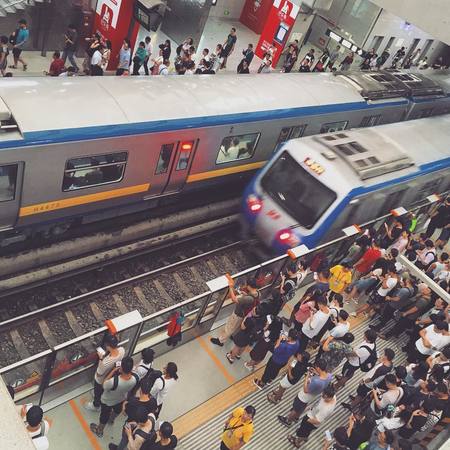 Xi'erqi Station
Xi'erqi Station
The more than 100 stations and 117 kilometers (72.7 miles) promised to be monumental. However, the project was abandoned due to the deterioration in relations between the Soviet Union and China. Construction restarted in 1965 as the people of China advanced the project. The demolishment of an internal wall to make way for construction was one of the major controversies that developed.
Four years later, following the founding of the People’s Republic of China, the first section of the Beijing Metro opened on October 1, 1969. It extended 21 kilometers (13 miles). The metro, which sustained accidents was militarized from 1970 to 1976. It was not until 1981 when a company was created to regulate the metro. A second line was opened in 1984 and the metro maintained the two lines, up until the beginning of the new millennium, two decades later.
Due to Beijing being named host of the 2008 Summer Olympics in 2001, the metro underwent a rapid-paced expansion. With a 7.69 billion (US dollar) expansion, the metro planned 19 lines in time for the sporting event. Even with the end of the Olympic Games, the urgency of the expansion project continued. Consequently, a 1000 km (621.4 mi) route is foreseen by 2020.
Lines and stations
The Beijing Metro’s 22 lines make it one of the systems with the most lines worldwide. Some lines are referred to by numbers while others are named. Operators also vary. The Beijing Metro lines are included below:
Line 1
With a 1969 inauguration, this was the Beijing Metro’s first line. It currently extends 30.4 kilometers (18.9 miles) and has 23 stations. 2 are surface level. The terminal stations are Pingguoyuan, in the Shijingshan district and Sihui East, in the Chaoyang district. The last expansion was in 1999. The line is identified by the color, dark red and the Beijing Mass Transit Railway Operation Corp. is the operating company.
Line 2
This is Beijing Metro’s circular line. It mainly travels along the city’s central zone through the districts of Xicheng and Dongcheng. The route opened in 1971 and the last expansion in 1989 makes it the system’s oldest line. There are 18 stations distributed along 23.1 kilometers (14.4 miles). Beijing Mass Transit Railway Operation Corporation operates Line 2 as well. Navy blue is the line’s identifying color.
Line 4
Line 4 was recently constructed. It opened in 2009 and was expanded in 2010. The line has 24 stations and a length of 28.2 kilometers (17.5 miles). One station is surface level. Its terminal stations are Anheqiao North in the Haidian district and Gongyixiqiao in the Fengtai district. The Beijing MTR Corporation is the operator. Line 4 can be identified by the color, teal.
 Beijing
Beijing
Line 5
This line has not benefited from an expansion since its inauguration in 2007. However, it has 23 stations, 7 of which are surface level. The total route is 27.6 kilometers (17.1 miles). Its terminal stations are Tiantongyuan North, in the Changping district and Songjiazhuang. in the Fengtai district. The line is managed by the Beijing Mass Transit Railway Operation Corporation and its distinguishing color is purple.
Line 6
This is the third longest line on the Beijing Metro, with 26 stations along its 42.8 kilometers (26.6 miles). It opened in 2012 and was expanded in 2014. The terminal station, Haidian Wuluju is in the Haidian district, while the other terminal station, Lucheng, is found in the Tongzhou district. Light brown is Line 6’s distinguishing color. The state-owned Beijing Mass Transit Railway Operation Corp is its operator.
Line 7
Identified by the color beige, Line 7 was recently constructed. It was inaugurated in 2014 and there have been no expansions. Currently, there are 19 stations and its length is 23.7 kilometers (14.7 miles). The terminal stops are Beijing West Railway Station, in the Fengtai district and Jiaohuachang, in the Chaoyang district. The operating company is Beijing Mass Transit Railway Operation Corp.
Line 8
Line 8 runs from Zhuxinzhuang, in the Changping district to Nanluoguxiang, in the Dongcheng district. There are 17 stations covering 26.6 kilometers (16.5 miles). 1 is surface level. Line 8 was inaugurated in 2008 for the Olympic Games and underwent its last expansion in 2013. It is also operated by the Beijing Mass Transit Railway Operation Corporation and can be identified by the color green.
Line 9
Line 9 is distinguishable by the color apple green. Opened in 2011 and expanded in 2012, this line covers 16.5 kilometers (10.3 miles) and has 13 stations. The terminal ones are National Library in the Haidian district and Guogongzhuang in the Fengtai district. The Beijing Mass Transit Railway Operation Corp also manages this line.
Line 10
This is the Beijing Metro’s second circular line. It covers a much larger radius and connects a greater part of the city than Line 2. At 57.1 kilometers (35.5 miles), Line 10 has become the metro’s longest line. This means it also has the most stations. There is a total of 45. It travels through various districts but the most notable is Fengtai. Line 10 is identified by the color, sky blue. The Beijing Mass Transit Railway Operation Corp. manages this line.
Line 13
Identified on maps by the color yellow, this extensive line travels in a semicircular route throughout northern Beijing. Its terminal stations are Xizhimen, in the Xicheng district and Dongzhimen in the Dongcheng district. It is 40.9 kilometers (25.4 miles). There are 16 stations. 15 are surface level due to it being one of the highest-level lines in the system. It was inaugurated in 2002 and its last expansion was in 2003. It is also managed by the public company, Beijing Mass Transit Railway Operation Corporation.
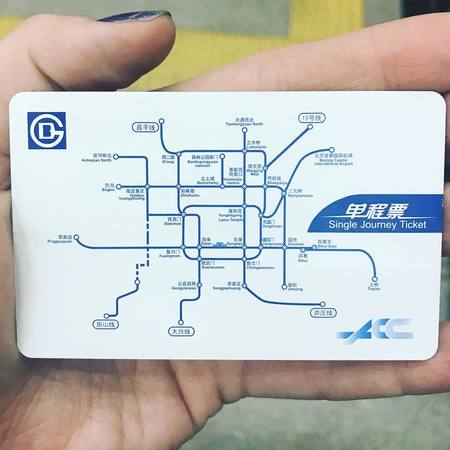 Tiananmen Square
Tiananmen Square
Lines 14 West and 14 East
These two lines currently operate separately but will be connected in the future. Therefore, they share the color, light pink. Line 14 West runs from Zhangguozhuang station in the Fengtai district to Xiju, also in the Fengtai district. It currently has 7 stations, 2 of which are surface level. It extends 12.4 kilometers (7.7 miles). Its inauguration was in 2013 and the last expansion was in 2014. Line 14 East has a similar background. It opened in 2014 and was expanded in 2017. The fact remains, however, that this line is much longer than its sister line. It covers 28.6 kilometers (17.8 miles) and has 21 stations. The terminal ones are Beijing South Railway Station, in the Fengtai district and Shangezhuang, in the Chaoyang district. The Beijing MTR Corporation manages both these lines.
Line 15
Distinguished by the color dark purple, this line is operated by the Beijing Mass Transit Railway Operation Corp. The terminal stations are Qinghuadongluxikou station in the Haidian district and Fengbo, in the Shunyi district. It was inaugurated in 2010 and expanded in 2017. At 45.7 kilometers (28.4 miles), this is the second longest line in the system though there are not many stations. There are 18 in total. 7 are surface level.
Line 16
Line 16’s distinguishing color is dark-moderate green. Opened in 2016 and expanded in 2017, this is the system’s second most recent line. It is operated by the Beijing MTR Corporation. There are 10 stations distributed along 19.6 kilometers (12.2 miles). The terminal stations are Bei'anhe and Xiyuan, in the Haidian district.
Batong Line
Opened in 2003, the Batong Line is part of Line 1’s eastern section. It is also operated by the Beijing Mass Transit Railway Operation Corporation and its terminal stations are Sihui, in the Chaoyang district and Tuqiao, in the Tongzhou. district. It is 18.9 kilometers (11.7 miles) with 13 stations. They are all surface level. The Batong Line is distinguished by the color, dark red.
Changping Line
This line opened in 2010 and is part of Line 13 in northern Beijing. It was expanded in 2015 to what currently consists of 12 stations and a length of 32 kilometers (19.9 miles). 6 stations are surface level. The terminal stations are Changping Xishankou, in the Changping district and Xi'erqi, in the Haidian district. The line’s distinguishing color is pink. Beijing Mass Transit Railway Operation Corporation is the operator.
Daxing Line
Daxing Line operates in southern Beijing as an extension of Line 4. The line has not been expanded since its opening in 2010. There are 12 stations covering 21.7 kilometers (13.5 miles). 1 is surface level and its terminal ones include Gongyixiqiao in the Fengtai district and Tiangongyuan in the Daxing district. Like Line 4, its distinguishing color is teal, and the Beijing MTR Corporation manages it as well.
Fangshang Line
Opened in 2010 and expanded in 2017, this line is 27 kilometers (16.8 miles). This line is an extension of Line 9. There are 12 stations, of which 10 are surface level. The terminal stations are Guogongzhuang, in the Fengtai district and Yancun East in the Fangshan district. Orange is this line’s distinguishing color and it is operated by the Beijing Mass Transit Railway Operation Corporation.
Yanfang Line
As an extension of the Fangshang Line, the Yanfang Line is also identified by the color orange. It travels from Yancun East station, in the Fangshan district to Yanshan, in the same district. It opened in 2017. The length is 14.4 kilometers (8.9 miles) and there are 8 stations, all surface level. This is the only line operated by the Beijing MTR Operation Administration.
Yizhuang Line
Opened in 2010, this line is 23.3 kilometers (14.5 miles). There are 13 stations. 8 are surface level. Its color is fuchsia, and it serves as an extension to Line 5. The terminal stations on this route are Songjiazhuang, in the Fengtai district and Ciqu in the Tongzhou district. The operating company is the Beijing Mass Transit Railway Operation Corporation.
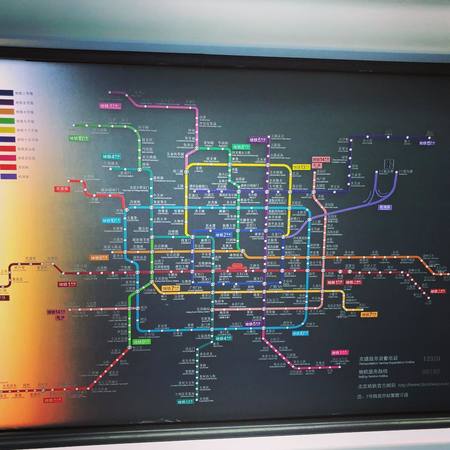 Tiananmen
Tiananmen
S1 Maglev Line
Located in western Beijing and opened in 2017, this line is the most striking. This is due to its short 8.25-kilometer (5.1-mile) route, which utilizes magnetic levitation technology. The S1 Maglev Line is the most rapid commercialized train system. All 7 of its stations are surface level. It has the distinction of having no connection to the rest of the Beijing Metro. The terminal stations are Jin'anqiao, in the Shijingshan district and Shichang, in the Mentougou district. The Beijing Mass Transit Railway Operation Corporation manages this line and its distinguishing color is brown.
Airport Express Line
As its name indicates, this line provides service to the Beijing Capital International Airport. Its terminal stations are Dongzhimen in the Dongcheng district, in the middle of the city and Terminal 2 and Terminal 3 stations in the Chaoyang and Shunyi districts, respectively. The Airport Express Line runs in a continuous circular pattern. Opened in 2008, this line is 28.1 kilometers (17.5 miles) and includes 4 stations. 1 station is surface level. Magnolia is the distinguishing color for this line, operated by the Beijing Capital Metro.
Xijao LRT Line
Distinguished by the color red, this line serves as a western extension to the circular Line 10. Its terminal stations are Bagou, in the Haidian district and Fragrant Hills, also in the Haidian district. It opened in 2017 and extends 8.8 kilometers (5.5 miles). There are 6 stations and due to it being a light rail, they are all surface level. The Beijing Public Transit Tramway company manages this line.
Connections to other systems
The Beijing Metro system is the most used transportation system in the Chinese capital. This became especially true following the fast-paced expansion that began in 2001. The system also works with other systems to provide service to the city.
The most significant are the Beijing buses, which are operated by the company, Beijing Public Transport Holdings, Ltd. ("BPT"). The company currently manages 1020 different routes. The Beijing Yuntong Bus Company, known simply as Yuntong, also provides riders with bus service on 32 routes.
Trolleybuses are included in the bus system. Four BTR lines travel in a cross like pattern to the city’s cardinal points. The city’s double decker and articulated buses are also significant.
Beijing has three suburban railway lines that include the S2 Line, the Sub-Central Line and the Huairou–Miyun Line. They connect various town populations to the city.
Similarly, the long-distance railway transportation includes three train stations. The Beijing station connects to the metro’s Line 2, while the eastern one connects to Lines 7 and 9, and the southern one connects to Lines 4 and 14. Medium-speed and high-speed trains can be taken from these stations to cities such as Shanghai and Tianjin. There is also an international destination train, on which riders can travel to Moscow, Ulaan Baatar, Pyongyang and Hanoi.
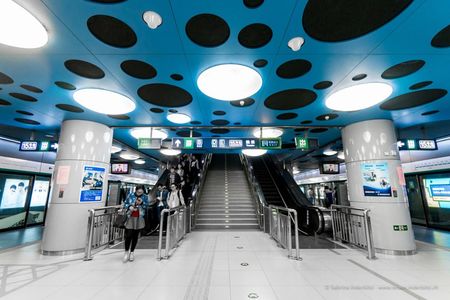 Olympic Green
Olympic Green
Connections to the airport
The Beijing Capital International Airport is the third busiest airport worldwide, just after the London-Heathrow Airport and the Hartsfield-Jackson International Airport in Atlanta. Terminal 3 opened in 2008 and became the world’s second largest terminal, after Dubai.
There is a direct connection to the Beijing Metro via the Airport Express Line. It travels directly to the airport terminals 1 and 2 at Terminal 2 station and to 3 at Terminal 3 station. The route is circular and connects to stations Sanyuanqiao on Line 10 and Dongzhimen on Lines 2 and 13.
Schedule and frequency
The Beijing Metro schedules vary depending on the line, although most operate between 5:00 a.m. and near midnight. The train frequencies are also similar. Included below are some train schedules and frequencies:
- Line 1: the first train departs from Sihui at 4:56 in the morning. The last train leaves Sihui East at 11:15 in the evening. Initially, trains depart every two minutes.
- Line 2: Line 2 is a circular line. The first train traveling in the direction of Xizhimen-Fuxingmen-Dongzhimen-Xizhimen, also known as the Outer Ring, departs at 5:00 a.m. The last train reaches Jishuitan station at 10:59 p.m. Initially, trains depart every two minutes, but this changes throughout the day.
- Line 4: The first train departs from Anheqiaobei station at 5:00 a.m. and the last train leaves Gongyixiqiao at 11:15 p.m. The frequency is every 2 to 7 minutes throughout the day.
- Line 5: the first train departs from Tiantongyuan North station at 4:59 in the morning. The last one leaves Songjiazhuang at 11:10 at night. The average frequency is between 2 and 5 minutes.
- Line 6: the first train departs from Caofang at 5:15 in the morning. The last one leaves from Cishousi at 11:56 in the evening. The average frequency is 2 minutes 50 seconds in peak hours during the week, and five minutes on weekends.
- Line 7: the first train leaves the West Railway Station at 5:30 in the morning. The last, however, arrives in Shuanghe at 11:56 at night. Frequency is 4 minutes during peak hours, and 6 during non-peak hours. On weekends frecuency is 5 minutes during peak hours and 7 during normal hours.
- Line 8: the first train departs from Pingxifu at 4:55. The last one arrives at Yuzhilu at 23:43. The frequency is around 3 minutes in peak hours.
- Line 9: the first train departs from Guogongzhuang station at 5:20 in the morning. The last, however, arrives at the Fengtai Science Park station at 23:47 at night. The frequency in peak hours is 3 minutes and 15 seconds.
- Line 10: this is the other circular line of the Beijing Metro. The first train leaves from Bagou station towards Chedaogou - Songjiazhuang - Guomao - Bagou, also known as outer circle, at 4:49 in the morning. The last train arrives, in this very same direction, to the Changchunqiao station at 00:24 at night. Its frequency is 2 minutes 30 seconds in the morning peak hours, 2 minutes and 5 seconds in the afternoon and 5 minutes the rest of the day in clockwise direction. On the other hand, in the counter-clockwise direction, in the peak hours of the morning the time between trains is 2 minutes and 5 seconds and in the afternoon, 2 minutes and 30 seconds. The rest of the day is 4 minutes and 10 seconds.
- Line 13: the first train leaves at 5 in the morning from the Huoying station. The last train of the day arrives at Huilongguan at 00:09 at night. The frequency in the busy hours is 3 minutes and a half in the morning and 5 minutes in the afternoon. The rest of the time is between 6 and 11 and a half minutes.
- Line 14 west and Line 14 east: on the west side, the first train leaves at 5:30 in the morning from Zhangguozhuang station. The last one arrives at Guozhuangzi at 10:36 at night. For the east side, the first train leaves at 5 in the morning from Shangezhuang. The last train arrives in Laiguangying at 23:30. The frequency varies between two and six minutes, approximately.
- Line 15: the first trains departs at 5:30 in the morning from Maquanying and Fengbo , while the last train arrives at Shunyi at 00:09 at night. The frequency is four minutes during peak hours in the week, while during peak hours on weekends is 6 minutes. The rest of the time, it's eight minutes.
- Line 16: the first train leaves Bei'anhe at 5:25 in the morning and the last one arrives in Wenyanglu at 23:22 in the evening. The frequency in peak hours is between two and four minutes, increasing at other times.
- Batong line: the first train leaves from Tuqiao station at 5:20 in the morning. The journey in this line concludes with the arrival of the final train to Linheli at 23:50 at night. The frequency intervals are between 3 minutes and a half and 6, in peak hours. On the other hand, in the other schedules it is between 4 and 12 and a half minutes.
- Changping Line: the first trains leaves at 5:40 in the morning from Life Science Park and Zhuxinzhuang . Operations finnish at 23:42 in the evening, with the arrival of the last train to the Ming Tombs station. The frequency in peak hours is 4 and a half minutes, while at other times it is 6 minutes.
- Daxing Line: the first train leaves the Tiangongyuan station at 5:30 in the morning. The last one arrives at 23:38 to the Biomedical Base station. The frequency ranges between two and six minutes.
- Fangshan Line: the first train departs from Yancun East at 5:11 in the morning. The last train arrives at the platform of the Suzhuang station at 23:57. Frequency ranges are approximately 5 minutes and 10 seconds during peak hours, and 8 minutes at other times.
- Yizhuang Line: the first train leaves from the Ciqu station at 5:23 in the morning. Its operations end at 23:14 at night with the arrival of the last train to Ciqu South. The frequency is between two and five minutes in the busiest hours.
- Yanfang Line: the first train departs from the Yancun East station at 5:05 in the morning . The last one arrives at 23:16 at night to the same station. The frequency is between two and six minutes during peak hours.
- Line S1: this modern line starts operating at 6 o'clock in the morning with the departure of the first electromagnetic train from the Shichang station. The last train arrives in Xiaoyuan at 21:14 in the evening. The frequency is between four and seven minutes.
- Airport Express Line: the first train leaves at 6 in the morning from Dongzhimen in the direction of the city's airport. The last train arrives at 23:28 at Sanyuanqiao station. Due to the characteristics of this line, the frequency is very slow, being between 12 and 20 minutes between train and train.
Fares, tickets and cards
The Beijing Metro fare system is based simply on the distance traveled. The upcoming table details the ticket costs as a function of the distance traveled on the chosen route. Fares start at 3 yuan ($US 0.44) and increase by 1 yuan ($US 0.15) for every fare zone reached. The first range is measured every 6 kilometers (3.7 miles), up to 12 (7.5), in which it changes to every 10 kilometers (6.2 miles). It then goes up to 32 (19.9), in which the count then changes to every 20 kilometers (12.4 miles).
The price for an Airline Express Line ticket is 14 yuan ($US 2.05).
Children under 1.3 meters (4.3 feet) travel free of charge, when accompanied by an adult.
Elderly adults over the age of 65, disabled passengers, retired revolutionary cadres, police and military veterans wounded in combat, military personnel and members of the People’s Armed Police ride free of charge.
Completing a trip in four hours is vital. If this time is exceeded, an additional fee of 3 yuan ($US 0.44) must be paid. The fares per distance are:
- Less than 6 km (3.7 miles): 3 yuan ($US 0.44)
- Between 6 (3.7) and 12 km (7.5 mi): 4 yuan ($US 0.59)
- Between 12 (7.5) and 22 km (13.7 mi): 5 yuan ($US 0.73)
- Between 22 (13.7) and 32 km (19.9 mi): 6 yuan ($US 0.88))
- Between 32 (19.9) and 52 km (32.3 mi): 7 yuan ($US 1.03)
- Between 52 (32.3) and 72 km (44.7 mi): 8 yuan ($US 1.17)
- Between 72 (44.7) and 92 km (57.2 mi): 9 yuan ($US 1.32)
- Between 92 (57.2) and 112 km (69.6 mi): 10 yuan ($US 1.47)
Another payment method is the Yikatong card. Passengers can purchase these cards and add to its balance at station ticket counters.
The Yikatong card is officially called the Beijing Municipal Administration & Communication Card (BMAC). This card can be used on the metro, the suburban train, urban and suburban buses and for other purposes as well. A minimum balance of 3 yuan (US$ 0.44) is required for use.
Riders who spend over 100 yuan ($US 14.67) in a calendar year will receive a discount off the next month. If they spend over 150 yuan ($US 22.00), any expenditure will be 20% discounted. If they spend between 150 ($US 22)) and 400 yuan ($US 58.67), they will receive a 50% discount. The Yikatong card discounts are:
 Yikatong Card discounts
Yikatong Card discounts
Future expansions
The goal is for the Beijing Metro to reach 1000 km (621.3 mi) by the year 2021. A continued growth, that began in 2001, is evident by the construction of lines and numerous expansions that will connect over 350 kilometers (217.5 miles). The focus is on current lines.
One of the most important expansions is connecting both ends of Line 14. The Fangshan Line will be extended to the city’s third ring zone and form a connection to Lines 10 and 16.
The opening of two new phases on Lines 6 and 8 will follow.
Extensions to Lines 7, 14, 16, Batong, Fangshan, and Airport Express are planned for 2019. Other plans for 2019 include the connection of the S1 Line to the rest of the system and the construction of the New Airport Line, that will connect to the city’s new airport.
Lines 3, 12, 17, 19, 28 and Pinggu will be opened by 2020, provided that the outlined plans are fulfilled. Lines Yanfang and Changping will be expanded as well.
Tips
On a metro as extensive as Beijing’s, it is important to keep certain tips in mind in order to be proactive and to avoid mishaps. Below are some tips:
-
It is important to familiarize yourself with your chosen route before entering the system. The Beijing Metro is large, and there is guaranteed to be a station near your final destination.
In order to make the proper ticket purchase, you should also be aware of your trip’s total kilometers. Otherwise, you could be fined for having the wrong ticket.
Depending on how much time will be spend in Beijing, decide whether it may be a better option to purchase the Yikatong card.
The Beijing Metro’s naming system is in Mandarin Chinese and Pinyin (the phonetic spelling of Chinese in Latin letters). English is also used, and it is important to have some basic knowledge of both languages.
Notable facts
- The Beijing Metro is the second largest in the world, after Shanghai, another Chinese city.
- It is the oldest metro in the country.
- It underwent an unprecedented growth, from 2 lines to 22. The process has been the same for other cities in China, such as Shanghai.
- Despite the system’s various operators, it is mainly or to some extent moderated by state-owned companies and regulated by the municipal government.
Sightseeing via Beijing Metro
Each year, this Chinese capital is paradise for millions of tourists. The traditional, historic China, including dynasties and republics has merged with the modern China, which is cosmopolitan, massive and westernized by the recent decades. Beijing is at the center of this movement and as a result, it has been transformed into an attractive and distinctive city that captivates its many visitors. The Beijing Metro is the most ideal transportation system for getting around the city. The 22 lines allow one to visit hundreds of places. Some of those include:
- Beijing Zoo: With an area of 89 hectares (220 acres), the Beijing Zoo is one the most famous zoos worldwide. This is due to its variety of over 450 terrestrial and 500 marine species. The zoo itself is a historical site, as it was founded by the Qing dynasty at the beginning of the twentieth century Tourists must simply get off at the Beijing Zoo station on Line 4 and cross the street to access it.
- The Palace Museum of the Forbidden City: This is one of the most well-known sites of the Forbidden City. It is one of Beijing’s most mythical places, due to previously housing the monarchy and later the nationalist communist government. The Palace Museum is also where the emperor held court. Admission should be purchased in advance due to a daily limit. The museum is accessible by traveling to Dongsi station (Lines 5 and 6) and walking via Wusi street in Jingshang. It is also possible to reach it by traveling to Tiananmen East station or Tiananmen West station on Line 1 and heading in the direction of the Forbidden City.
- Temple of Heaven: This is an imperial and religious temple located in southeastern Beijing. It is notable for its circular shape and its origin as a Taoist temple. It has been declared a UNESCO World Heritage site and contains a symbolism, characteristic of the Chinese culture. To reach this site, one may travel to Tiantandongmen station on Line 5, found near the east door of the temple.
Beijing Subway map
- Also Known As: Subway
- Passengers/Day 5630000
- Fares: 0.15 EUR (2009); access/exit gates
- 24h operation: No
- Air Conditioning: Yes
- Walk between platforms: All lines
- Driverless trains: No
- Screen Doors Platforms: PGDs on underground stations of line 5, PSDs on lines 8, 10
- Operator: Beijing Mass Transit Railway Operation Corp., Ltd Beijing MTR Corp. Ltd.
- 2 yuan
- Beijing Metro Official Website
Help us
If you consider that the information we provide is wrong, not accurated, outdated, translation contains errors, and you would like to help us to improve the file...you can contact us here.
Feel free to contact us if you dont find the system you're looking for and we'll add it as soon as we can!
Thank you very much!







